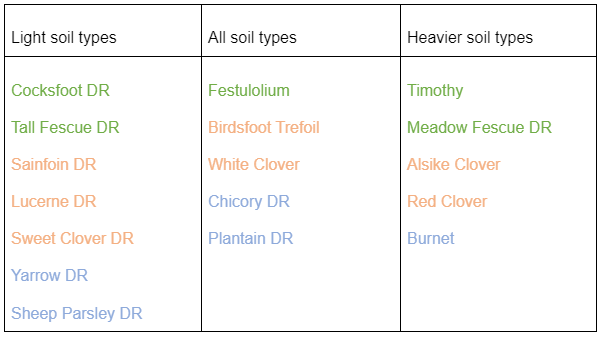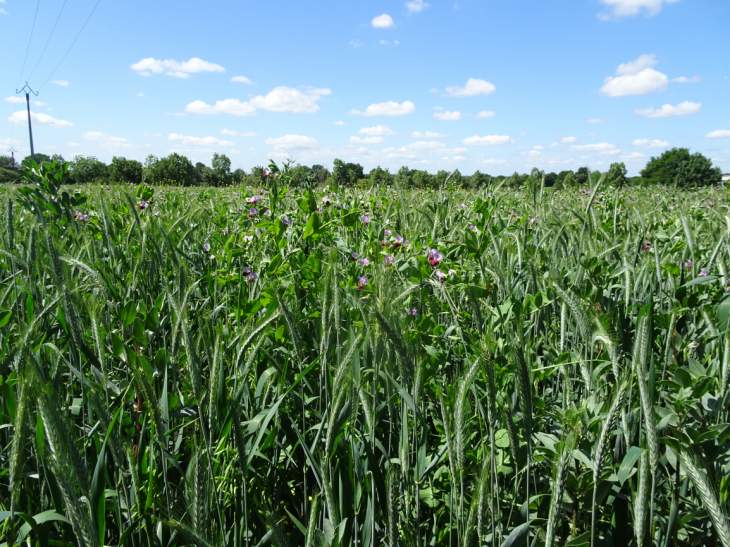Mixtures of grasses and clovers or grasses with herbs and clovers are commonly used to provide fertiliser free grasses and a more diverse pasture, the mixture of grasses provides a more balanced ration for the livestock as well as more resilience to drought. Mixtures of grass species will provide a more diverse sward structure with less opportunities for weed seedlings.
Diverse Forage - Swarm Hub (English)
The benefits of herbal leys (English)
The herbal ley farming system - why it's lasted over 100 years (English)
Information on mixed crops (cereals and legumes) used for silage can be find here (French only):
Information about herbal leys and other mixed plants for pasture, you can find here (French only):
Cost and benefits
Although diverse seed mixtures will be a more expensive than monoculture mixes, the benefits of reduced fertiliser cost, resilience of sward and nutritional value to livestock outweigh that additional cost (Herbal leys for diary). Mixed grass will often last longer than fertilised single species mixes, saving the additional costs of reseeding.
Choice of species
Groups of crops choosen
Herbal leys are a complex forage mix of grasses, herbs and legumes. Having a diverse species mix makes the sward work harder overall, with different plants performing different functions e.g. fertility building, soil improving, delivering for biodiversity and providing mineral rich nutritious forage to livestock.
Multi species forage crops can range from three species up to 30 species. The diversity chosen will depend on use of the forage e.g. grazed or cut, soil type, the expected longevity of the sward and the different purposes desired from the species. A minimum of 6 species in order to get a range of plant functions is best.
Multi species sward will be a combination of grass and legumes, or grasses, legumes and herbs. With each plant having a different role.
Diverse Forages project (English)
How to capture the benefits of multi-species swards (English)
Multi-species sward app (English)
Examples of combinations
Simple mixes:
- Rye Grass combined with nitrogen fixing while clover
- Simple combination of grasses, cover and chicory and plantain (English)
- Diverse mixes (English)
- Mixes for specific soil type - heavy clay soil (English)
Relation to soil
Herbal leys have proven to be of great value in periods of dry weather, particularly on light land. Where the deep rooting species (e.g. Chicory, Plantain, Sainfoin, Cocksfoot) are able to access and bring up moisture from deep in the soil. These deep rooting species also put carbon deeper into the soil where it is less likely to be released. The deep roots improve soil structure enabling other species to increase rooting depth. This enables all these plants to produce growth during periods of drought.
Additionally, herbal leys have proven very successful on heavier land in periods of high rainfall. The extensive rooting system provides a sponge to absorb moisture and again the deep rooting species break up the soil structure improving infiltration and drainage and relieve compaction.
Species section for variable soil types:
Establishment
You need to plan when establishing herbal leys. If you are doing a reseed you need to think about how you can change your rotation as needed in order to gain a planting window. If you are thinking about trying to establish in an existing ley with overseeding, then again planning and timing is critical and you need to grasp an opportunity for example if the ground is poached after drought or winter damage.
Legumes and herbs need a warm soil (8 - 10 degrees) with good levels of soil moisture to germinate. The best time to sow is in autumn (August - early September) or in spring (April - May).
Méteil (Chambres d'agriculture - Pays-de-la-Loire)
Full seed bed preparation, ploughing, harrow and rolling to really work to a fine seed bed has proven to be most successful. Although through the TOMS project it demonstrated that tillage depth had no overall impact on dry matter yield. The project had success with Power harrow to 5cm depth and disc harrow to 10-15cm depth – but this is going to be soil type dependant and the key with whatever depth you cultivate is to establish a fine a bed as possible.
Broadcast sowing is most successful to ensure even distribution and reduce weed ingress and to ensure you sow as shallow as possible. If you drill then this needs to be very shallow as many of the species have small seeds that can be lost if sown too deep. Sow no deeper than 1cm.
Soil contact needs to be the focus so rolling a minimum of twice is recommended to ensure good contact and lock in soil moisture – roll before and after sowing.
7 top tips on establishing herbal leys
Herbal grazing leys: Sowing and Growing
The herbal ley farming system - Why it's lasted over 100 years
Grazing, cutting and silage
Some important aspects to consider when grazing herbal leys to maximise production and longevity:
- Long rotation, higher stocking rate grazing systems are most effective, back fencing where possible e.g. cell grazing, mob or paddock systems
- Graze the sward clean, with higher stocking rate on smaller area
- Allow long rotation for swards to put on maximum green leaf, maximising photosynthesis converting sunlight into sugars and protein enabling plants to build strong roots, and feed soil microbes along with feeding livestock. Allow a minimum of 20 – 30 day regrowth.
- Don’t overgraze, leaving a minimum 7 – 10 cm residual. Be particularly careful to prevent overgrazing by sheep.
Forage:
- Cut frequently to optimise silage quality. You can use a more simple seed mix if predominantly growing for silage.
- It is advised not to make hay from herbal leys and can be difficult to get high enough dry matter without shattering.
Tips on establishing and managing herbal leys

